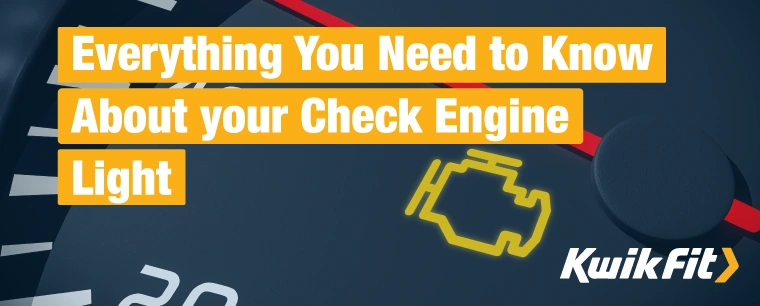Everything You Need to Know About the Check Engine Light
Jack Dreyer | Tuesday 27th September 2022 5:35pm

If cars could talk, they would. They do try through the warning lights and alarms they give off when a problem occurs. Though knowing exactly what these lights mean can be complicated if you aren’t a particularly experienced driver or haven't encountered these faults before.
If your check engine light has turned on but you aren’t sure why or what to do, read on and we’ll get to the bottom of the problem together.
What is the check engine light?

The check engine (sometimes abbreviated to ‘CEL’) light is a small symbol located on your dashboard. This light glows orange when something engine-related is wrong and, for that reason, should never be ignored. You can easily tell this light apart from the many other symbols on your dashboard from its distinctive shape.
Naturally, the check engine light is shaped like an engine and will illuminate when your vehicle’s onboard computer senses a problem. The engine light is very communicative if you understand what it is trying to tell you.
Different types of check engine light
Most commonly, if it shows, your check engine light will take the form of a bright, orange light. This indicates that there is a slight problem with the engine, but nothing major. If this happens, there is no need to get flustered and pull over immediately. You’d be able to tell if there was something tragically wrong with the engine by feeling unusual handling or hearing noises while driving the car.
The other kind of check engine light is the blinking kind. Depending on the make of your car, this may also be revealed as a solid red light (instead or orange). This light is used to indicate a far more serious problem with the engine which should be addressed immediately. But what should you do?
What to do if your check engine light turns on

If your yellow check engine light appears, you should continue on your journey but when you’ve reached your destination, you should make plans to get it checked out. Booking an appointment for a car engine diagnostic test at your nearest Kwik Fit is a good idea. These tests can tell you lots of information about your car’s inner workings. After all, it is likely to be a mechanical issue that requires a diagnosis and action from an expert in any case.
If the destination is miles and miles away, it is recommended that you stop and get it checked out before you proceed. In an ideal world, you would have performed checks on your engine and other core areas of your vehicle before going on a long journey anyway.
If the check engine light is flashing or a solid red, you should pull over where safe to do so and arrange to have your car recovered. This light indicates a dangerous fault and should not be ignored. If you are often worried about your engine’s health and performance, you can book in for an engine treatment with Kwik Fit today.
Why is your check engine light showing?

There are a whole host of reasons as to why your check engine light could be showing at any given time. Work your way through the list of reasons below, ticking off each one to be sure to find the culprit.
1. The fuel cap is loose
The fuel tank is lined with valves which prevent the vapours from the gasoline from escaping. These valves do this by recirculating the fumes back into the tank. However, if there is a leak, the check engine light will be sure to show as it becomes a fuel evaporation issue.
2. Your oxygen sensor has failed
Similarly to gasoline fumes, the oxygen sensor (occasionally called the O2 sensor) is responsible for measuring the amount of oxygen in a car’s exhaust system. The data from this sensor is sent to the vehicle’s computer which uses it to regulate the amounts of air and fuel that enters the cylinders.
If the oxygen sensor is playing up, the engine will still run but is likely to be burning more fuel which nobody wants. Eventually, this can lead to damage to the spark plugs and catalytic converters or even make a vehicle fail an emissions test.
3. The catalytic converter has failed or is faulty
A faulty catalytic converter will massively reduce your fuel economy and increase your emissions. This is bad news if you’re planning on inner-city driving in places like the ULEZ in London. Unfortunately, these pieces of equipment don’t often have a simple fix as they are usually thrown off by other damage such as a blown head gasket.
4. Spark plug & ignition issues
The ignition coil is a necessity for igniting the fuel and air mixture in the cylinders. Without a functioning one, you aren’t likely to get very far (unless, of course, you run a diesel engine which doesn’t have one at all). If your spark plugs are worn out, they can cause your engine to misfire and perform poorly when accelerating. The car may even stop unexpectedly which is so dangerous.
This can also extend to the spark plug wires which may be faulty. These wires are what transfer the electricity between the coil and the plug. If these wires get eroded or damaged, there can be no ignition of the air and fuel mixture in the cylinders at all!
5. Your battery is dead
Lastly, while it may seem obvious, the check engine light on your dashboard may be lit due to a battery issue. Remember, if you’ve recently disconnected the battery, the electrics in your car may need tweaking slightly. For example, the time & stations on the stereo may need to be reset.
While these are the most common reasons, a check engine light may also flash or show if:
- The exhaust gas recirculation valve has failed
- There has been a vacuum leak
- There is an issue with your aftermarket alarm system
- Your mass airflow sensor has failed
Stay safe with Kwik Fit
If you ever encounter any problems with your engine, be sure to speak to the experts at Kwik Fit about it for that peace of mind you desire. In the meantime, you can find out more about the signals from your car over on our blog.
Any facts, figures and prices shown in our blog articles are correct at time of publication.
Featured Articles
Is Your Car Battery Ready for Winter?
Monday 11th November 2024
Is the UK on the verge of ‘the coldest winter for 50 years?’ Even if El Niño doesn't hit the UK this winter, reduce the risk of a winter breakdown by making sure your car battery is winter-ready.
Your Ultimate Winter Driving Checklist
Monday 31st October 2022
Driving in the colder months presents many challenges. Breakdowns are far more common in winter, so make sure you’re prepared with these essentials.
How to Get Your Car Ready for Winter
Wednesday 28th September 2022
Winter can be a harsh season for your car but planning ahead by carrying out some basic maintenance and packing some essential kit should help you avoid a winter breakdown.







